If you did a 23andMe test, then you almost definitely have DNA Relatives on your results. In this post, learn what this means and how these individuals are related to you.
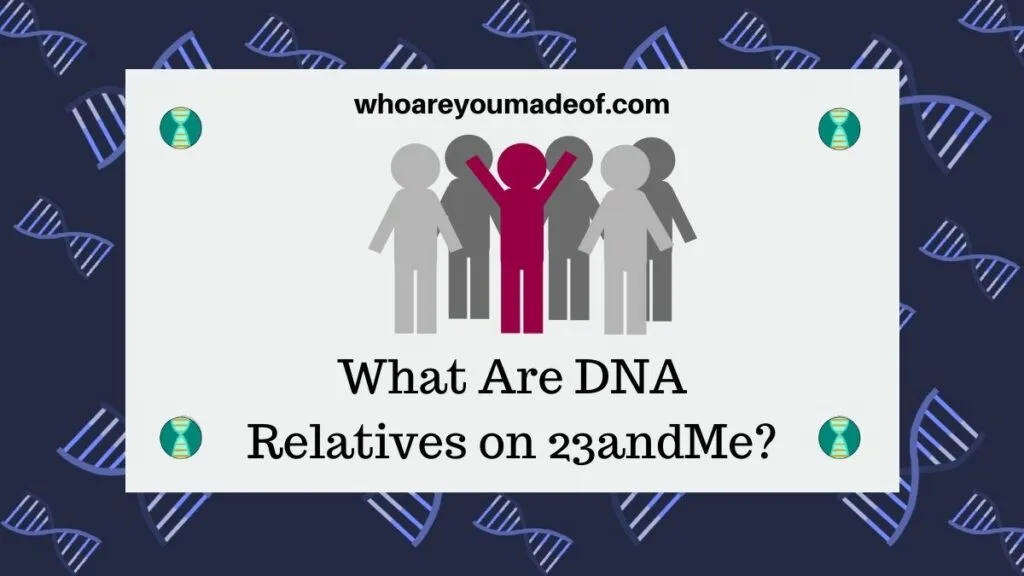
I get so excited when start thinking about DNA Relatives because they are the best part of DNA results, in my opinion. Although 23andMe definitely offers a lot of really cool tools and insights into our ancestry, the DNA Relatives are where things get really interesting.
How to find your DNA Relatives
You can find your DNA Relatives list from your main 23andMe results page. On the top of the page you should hover over the tab that says "ANCESTRY", and choose "DNA Relatives" from the drop-down menu that appears.
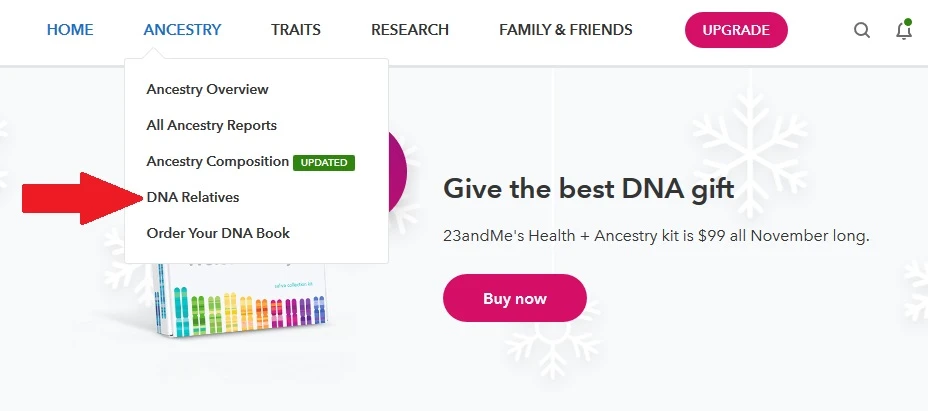
Once you click to access your DNA Relatives, you will be taken to a new page on the 23andMe site that will provide a list of your DNA Relatives.
What exactly is a DNA Relative?
A DNA Relative is a person who has also done a DNA test with 23andMe who shares at least one identical segment of DNA with you. When someone new takes a DNA test, 23andMe runs their DNA data through their software to find other customers who match them.
These individuals will show up in the DNA Relatives list as your genetic relatives.
Two people who are related to each other might share segments of D NA that they inherited from their shared ancestor. We share DNA with many relatives, even if we have never met them before or we don't know how they might fit into our family tree.
DNA Relatives are the same concept as what is called a "DNA match" on other testing company sites.
How to know how you are related to your DNA Relatives
While reading through a list of potentially unfamiliar names and DNA details might seem overwhelming at first, your 23andMe results actually give you a lot of information that can help you figure out who these relatives are to you and where they fit in on your family tree.
At the top of the page, you will see your DNA relative's name, as well as any other details that they might have included on their profile, which can provide important clues about your potential relationship. Sometimes they will even write a little paragraph about why they decided to take a DNA test, or what kind of information they are hoping to find or share with others.
This is a great opportunity for you to take the time to access your account settings to make your that your profile is updated, too. That way, your DNA Relatives can learn about their connection with you, too.
Check out your genetic relationship
The first information to examine is the details concerning your genetic relationship with your DNA match. 23andMe provides a predicted relationship, which is based on the amount of DNA that you share with your relative.
You will also see a visual representation of that estimated relationship. As an example, I have included a screen capture from one of my relatives and their DNA match.
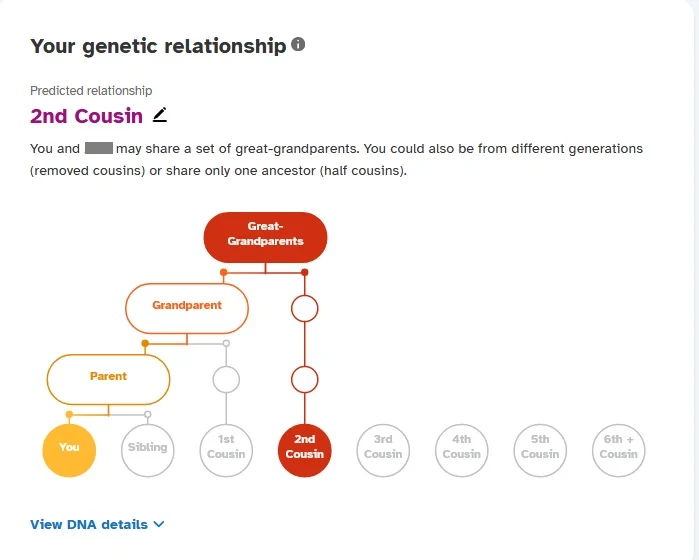
Based on the shared DNA of 192 centimorgans (cMs), 23andMe estimates that these two people are second cousins. The visualization shows us that they could potentially both be descended from the same great-grandparents.
It should be noted that the predicted relationship and the accompanying graphic are based solely on the amount of DNA that these two people share. There is always a range of shared DNA for any relationship, and most of those ranges overlap with other relationships.
This means that we should consult a good centimorgan chart to see all of the potential relationships we could have with our relative.
You might notice that at the bottom of the image above there is blue text that says "View DNA Details". If you click that link on your DNA match profile page, this section will expand to show additional information.
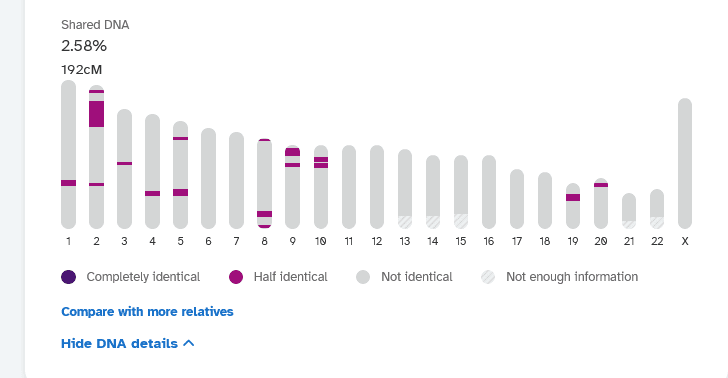
This is where you will find the exact amount of shared DNA in both a percentage and centimorgans. You will also see all 23 of your chromosomes, including the X-chromosome, and your identical DNA segments shown at their precise locations.
Compare your family background
If you continue to scroll down the DNA Relative profile page, you will find the Family Background section. If you and your DNA match have both included information about where your maternal and paternal ancestors where born, as well as surnames that appear in your family tree, you will be able to compared this information.
This is where you might find a link to your DNA Relative's family tree, if they have created on and posted it somewhere online. This is a great place to find out about your relative's ancestors to see if you can spot a connection with your own.
Examine your Ancestry Composition Reports side by side
If you continue to scroll on the match profile page, you will find a comparison of your Ancestry Composition reports. This is essentially a comparison of your ethnicity estimates, which can give you an idea about where your ancestors came from.
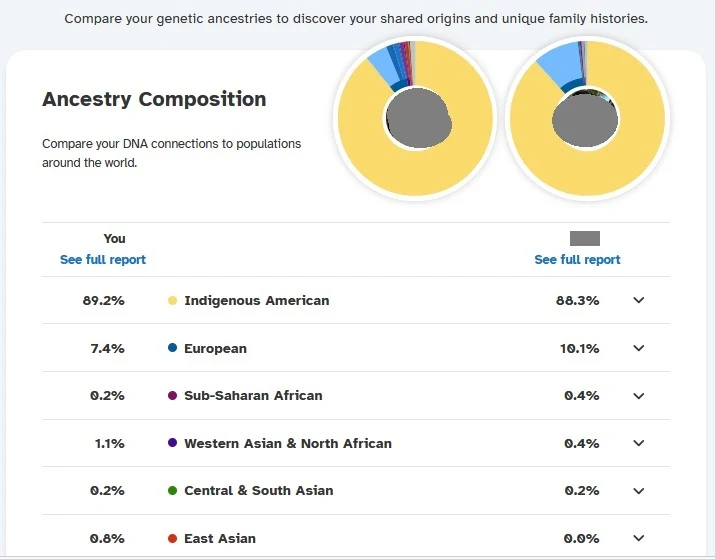
You might be able to find a region that you share in your Ancestry Composition report that gives you an idea about which ancestors you share in common.
For example, if you are 75% French & German with 25% Spanish % Portuguese DNA inherited from your maternal grandmother, and your relative is 90% Sub-Saharan African DNA with 10% Spanish DNA, you might be able to work on the assumption that you and your match are related through your Spanish grandmother's side of the family.
Note your haplogroups
Further down the page you will also see and be able to compare your maternal and paternal haplogroups with your DNA relative. Males will have a maternal and paternal haplogroup, and females will have a maternal haplogroup.
People who are descended from the same direct-line maternal ancestors will share the same maternal (mtDNA) haplogroup, and males who are descended from the same direct-line male (Y-DNA) ancestors will share the same paternal haplogroup.
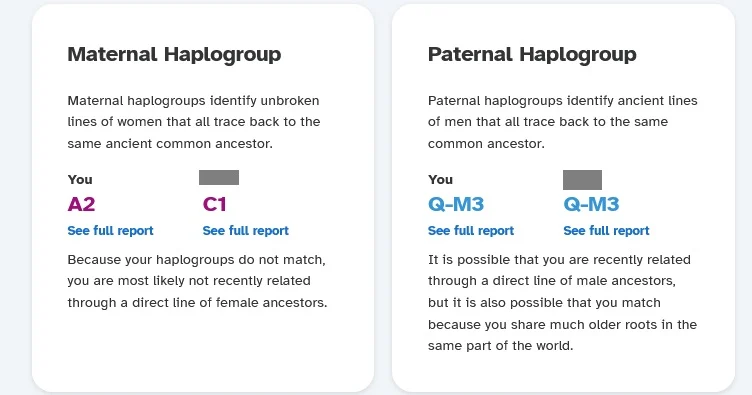
The haplogroup information on 23andMe can usually only be used to eliminate a potential relationship. For example, the image above shows that my relative and their DNA match do not share the same direct-line maternal (mtDNA) haplogroup.
This means that they are not related through their mother's mother's mothers (etc) line. However, they could be related in any number of other ways.
These two people do share the same paternal haplogroup. This doesn't necessarily mean that they share autosomal DNA, the kind of DNA that 23andMe uses for identifying DNA relatives, through their father's father's father's (etc) line of the family.
Haplogroups can go back thousands of years. It's actually pretty neat!
View your Relatives in Common
The last bit of information that you should look at for your DNA Relatives is called the "Relatives in Common" tool. It's a blue button at the bottom of the page, and if you click on it, a list of people who are related to both you and your DNA match will load.

Relatives in Common, also known as "shared matches" on other sites, can give you additional information about how you and your DNA Relative are related to each other. If you see family members who you recognized on the Relatives in Common list, you will know that you are related on the same side of the family as those relatives.
How many DNA Relatives do most 23andMe testers have?
23andMe displays our top 1500 DNA matches. The default way that our DNA Relative list is displayed is to list those 1500 relatives in order from most closely related, listing our very distant relatives towards the end of the list.
Technically, a person has to have at least one 7 centimorgan DNA segment in order to show up as a match to us on the site. However, since there is a limit of 1500 DNA Relatives, most people will not find those very small, very distant matches.
Because our DNA Relative list is limited to our 1500 closest relatives on 23andMe, we get to focus on figuring out how we are connected to these people who are almost definitely related to us in some way.
Conclusion
I hope that this article has helped you understand everything that you needed to know about what DNA Relatives really are, how they get this list of people, and how to figure out exactly who these individuals are in your family tree.
If you have any questions about something that you read here, or if you would like to ask a specific question about a DNA Relative relationship that you see on your own list, I would love to hear from you in the discussion below.
Thanks for stopping by!
